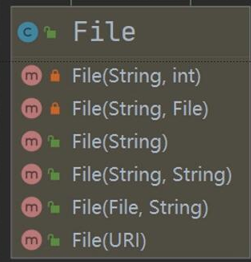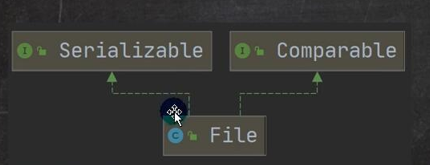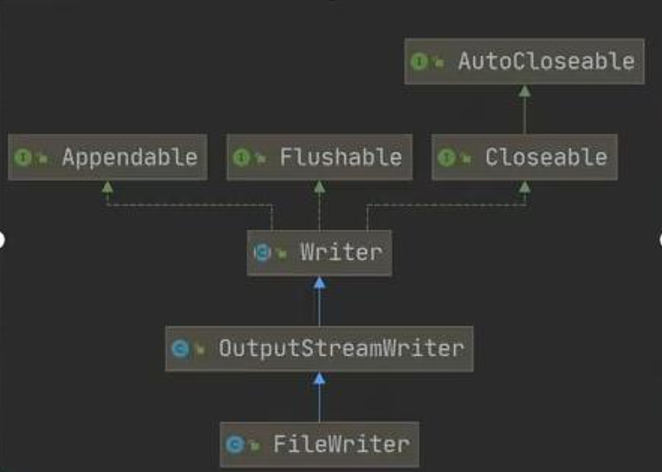文件
文件流
文件在程序中是以流的形式来操作的

流
数据在数据源(文件)和程序(内存)之间经历的路径
- 输入流:数据从数据源(文件)到程序(内存)的路径
- 输出流:数据从程序(内存)到数据源(文件)的路径
常用的文件操作
创建文件对象相关构造器和方法
new File(String path)根据路径构建一个File对象new File(File parent , String child)根据父目录文件+子路径构建new File(String parent , String child)根据父目录+子路径构建createNewFile创建新文件


获取文件的相关信息
getNamegetAbsolutePathgetParentlengthexistsisFileisDirectory

目录的操作和文件删除
mkdir创建一级目录mkdirs创建多级目录delete删除空目录或文件

IO流原理及流的分类
I/O是Input/Output的缩写,I/O技术是非常实用的技术,用于处理数据传输。如读/写文件,网络通讯等- Java程序中,对于数据的输入/输出操作以"流(stream)"的方式进行。
java.io包下提供了各种"流"类和接口,用以获取不同种类的数据,并通过方法输入或输出数据- 输入input: 读取外部数据(磁盘、光盘等存储设备的数据)到程序(内存)中。
- 输出output: 将程序(内存)数据输出到磁盘、光盘等存储设备中
流的分类
-
按操作数据单位不同分为
- 字节流(8 bit)二进制文件
- 字符流(按字符)文本文件
-
按数据流的流向不同分为
- 输入流
- 输出流
-
按流的角色不同分为
- 节点流
- 处理流/包装流
| 抽象基类 | 字节流 | 字符流 |
|---|---|---|
| 输入流 | InputStream | Reader |
| 输出流 | OutputStream | Writer |
- Java的IO流共涉及40多个类,实际上都是从如上4个抽象基类派生的
- 由这4个类派生出来的子类名称都是以其父类名作为子类名后缀
[外链图片转存失败,源站可能有防盗链机制,建议将图片保存下来直接上传(img-NugZvRQy-1638116605258)(https://pumpkn.xyz/upload/2021/09/image-3230be943cab492ab2fd25378871d88c.png)]
InputStream: 字节输入流
InputStream抽象类是所有字节输入流的超类
InputStream常用的子类
FileInputStream文件输入流BufferedInputStream缓冲字节输入流ObjectInputStream对象字节输入流
FileInputStream的使用
public class z1_FileInputStem {
java.lang.String filePath = "D:\\z1.txt" ;
/**
* fileInputStream.read()
* 每次读取一个字节,若文件为空,则阻止该方法。
* 若读到文件末尾,返回-1
* */
@Test
public void readFile(){
int readData ;
try {
FileInputStream fileInputStream = new FileInputStream(filePath);
while( ( readData = fileInputStream.read() ) != -1 ){
System.out.print((char)readData);
}
} catch (FileNotFoundException e) {
e.printStackTrace();
} catch (IOException e) {
e.printStackTrace();
}
}
/**
* 定义一个byte数组
* fileInputStream.read(bytes)
* 每次最多读取byte数组长度的字节,
* 返回读取的字节数
* 文件末尾返回-1
* */
@Test
public void readFileLength(){
byte[] bytes = new byte[8] ;
int readLen ;
try {
FileInputStream fileInputStream = new FileInputStream(filePath);
while( ( readLen = fileInputStream.read(bytes) ) != -1 ){
System.out.println(new java.lang.String(bytes , 0 , readLen));
}
} catch (FileNotFoundException e) {
e.printStackTrace();
} catch (IOException e) {
e.printStackTrace();
}
}
}
FileOutputStream的使用
public class z2_FileOutputStem {
@Test
public void write(){
String filePath = "D:\\a.txt" ;
FileOutputStream fileOutputStream = null ;
try {
//fileOutputStream = new FileOutputStream(filePath) 覆盖文件原有内容
//fileOutputStream = new FileOutputStream(filePath , true) 每次追加在文件内容后边
fileOutputStream = new FileOutputStream(filePath , true) ;
String str = "hello world" ;
fileOutputStream.write(str.getBytes());
//读取str的[0,3)范围的字节
fileOutputStream.write(str.getBytes() , 0 , 3);
} catch (FileNotFoundException e) {
e.printStackTrace();
} catch (IOException e) {
e.printStackTrace();
} finally {
try {
fileOutputStream.close();
} catch (IOException e) {
e.printStackTrace();
}
}
}
}
文件拷贝
public class z3_文件拷贝 {
public static void main(String[] args) throws IOException {
String srcFilePath = "D:\\zaizai.jpg" ;
String destFilePath = "D:\\zhouzhou.jpg" ;
FileInputStream fileInputStream = null ;
FileOutputStream fileOutputStream = null ;
try {
fileInputStream = new FileInputStream(srcFilePath) ;
fileOutputStream = new FileOutputStream(destFilePath) ;
byte[] bytes = new byte[1024] ;
int readLen ;
while( (readLen = fileInputStream.read(bytes)) != -1 ){
fileOutputStream.write(bytes , 0 , readLen);
}
} catch (Exception e) {
e.printStackTrace();
}finally {
if( fileInputStream != null ){
fileInputStream.close();
}
if( fileOutputStream != null ){
fileOutputStream.close();
}
}
}
}
FileReader和FileWriter类
FileReader和FileWriter是字符流,即按照字符来操作io

FileReader相关方法
new FileReader(File/String)read每次读取单个字符,返回该字符,如果到文件末尾返回-1read(char [])批量读取多个字符到数组,返回读取到的字符数,如果到文件末尾返回-1
相关API
new String(char[])将char[]转换成Stringnew String(char[] , off, len)将char[]指定部分转换成String
public class z1_FileReader {
/**
* fileReader.read()
* 每次读取一个字符
* */
@Test
public void FileRead(){
String filePath = "D:\\stroe.txt" ;
FileReader fileReader = null ;
try {
fileReader = new FileReader(filePath);
int data ;
while( (data = fileReader.read()) != -1 ){
System.out.print((char)data);
}
} catch (FileNotFoundException e) {
e.printStackTrace();
} catch (IOException e) {
e.printStackTrace();
}finally {
if( fileReader != null ){
try {
fileReader.close();
} catch (IOException e) {
e.printStackTrace();
}
}
}
}
@Test
public void fileReadMore(){
String filePath = "D:\\stroe.txt" ;
FileReader fileReader = null ;
try {
fileReader = new FileReader(filePath) ;
int readLen ;
char[] chars = new char[1024] ;
while( (readLen = fileReader.read(chars)) != -1 ){
String s = new String(chars, 0, readLen);
System.out.print(s);
}
} catch (FileNotFoundException e) {
e.printStackTrace();
} catch (IOException e) {
e.printStackTrace();
}
finally {
if( fileReader != null ){
try {
fileReader.close();
} catch (IOException e) {
e.printStackTrace();
}
}
}
}
}
FileWriter相关方法
new FileWriter(File/String)覆盖模式,相当于流的指针在首端new FileWriter(File/String, true)追加模式,相当于流的指针在尾端write(int)写入单个字符write(char[])写入指定数组write(char[] , off , len)写入指定数组的指定部分write(String)写入整个字符串write(String , off , len)写入字符串的指定部分
相关API
-
String类:toCharArray: 将String转换成char[]
注意:FileWriter使用后,必须要关闭(close)或者刷新(flush),否则写入不到指定文件!
节点流和处理流
基本介绍
- 节点流可以从一个特定的数据源读写数据,如FileReader、FileWriter
- 处理流(也叫包装流)是“连接”在已存在的流(节点流或处理流)之上,为程序提供更为强大的读写功能,如BufferedReader、BufferedWriter
节点流和处理流的区别和联系
- 节点流是底层流/低级流,直接跟数据源相接
- 处理流(包装流)包装节点流,既可以消除不同节点流的实现差异,也可以提供更方便的方法来完成输入输出。
- 处理流(也叫包装流)对节点流进行包装,使用了修饰器设计模式,不会直接与数据源相连
处理流的功能主要体现在
- 性能的提高:主要以增加缓冲的方式来提高输入输出的效率
- 操作的便捷:处理流提供了一系列便捷的方法来一次输入输出大批量的数据,使用更加灵活方便
BufferedReader和BufferedWriter——字符处理流
BufferedReader和BufferedWriter属于字符流,是按照字符来读取文件的- 关闭处理流时,只需要关闭外层流即可
BufferedReader的使用
public class z1_BufferdReader {
public static void main(String[] args) throws IOException {
String filePath = "D:\\stroe.txt" ;
BufferedReader bufferedReader = new BufferedReader(new FileReader(filePath));
String line ;
while( (line = bufferedReader.readLine()) != null ){
System.out.println(line);
}
bufferedReader.close();
}
}
BufferedWriter
public class z2_BufferedWriter {
public static void main(String[] args) throws IOException {
String filePath = "D:\\bufferedWriter.txt" ;
BufferedWriter bufferedWriter = new BufferedWriter(new FileWriter(filePath , true));
bufferedWriter.write("hello1 , world !");
bufferedWriter.newLine(); //写入一个与系统符合的换行符
bufferedWriter.write("hello2 , world !");
bufferedWriter.newLine();
bufferedWriter.write("hello3 , world !");
bufferedWriter.close();
}
}
BufferedInputStream和BufferedOutputStream——字节处理流
-
BufferedInputStream是字节流,在创建BufferedInputStream时,会创建一个内部缓冲区数组。 -
BufferedOutputStream是字节流,实现缓冲的输出流,可以将多个字节写入底层输出流中,而不必对每次字节写入调用底层系统
ObjectInputStream和ObjectOutputStream——对象流
看一个需求
将int num = 100 这个int数据保存到文件中,注意不是100这个数字,而是int 100 , 并且能够从文件从直接恢复int 100
将Dog dog = new Dog("小黄" , 3)这个dog对象保存到文件中,并且能够从文件中恢复
上面的要求,就是能够将基本数据类型或者对象进行序列化和反序列化操作
序列化和反序列化
-
序列化就是在保存数据时,保存数据的值和数据类型
-
反序列化就是在恢复数据时,恢复数据的值和数据类型
-
需要让某个对象支持序列化机制,则必须让其类时可序列化的,为了让某个类是可序列化的,该类必须实现如下两个接口之一
Serializable// 这是一个标记接口Externalizable
ObjectOutputStream的使用
public class z3_ObjectOutputStream {
public static void main(String[] args) throws IOException {
String filePath = "D:\\objectOutputStream.dat" ;
ObjectOutputStream oos = new ObjectOutputStream(new FileOutputStream(filePath)) ;
oos.writeInt(100);
oos.writeBoolean(true);
oos.writeUTF("周");
oos.writeObject( new Dog("邦邦" , 3) );
System.out.println("存储完毕");
oos.close();
}
}
class Dog implements Serializable {
private String name ;
private int age ;
public Dog(String name, int age) {
this.name = name;
this.age = age;
}
}
注意事项
- 读写顺序要一致
- 要求实现序列化或反序列化对象,需要实现
Serializable - 序列化的类中简直添加
SerialVersionUID,为了提高版本的兼容性 - 序列化对象时,默认将里面所有属性都进行序列化,但除了static或transient修饰的成员
- 序列化对象时,要求里面属性的类型也需要实现序列化接口
- 序列化具备可继承性,也就是如果某类已经实现了序列化,则它的所有子类也已经默认实现了序列化
InputStreamReader和OutputStreamWriter——转换流
InputStreamReaderReader的子类,可以将InputStream(字节流)包装成Reader(字符流)OutputStreamWriterWriter的子类,可以将OutputStream(字节流)包装成Writer(字符流)- 当处理纯文本数据时,如果使用字符流效率更高,并且可以有效解决中文问题,所以建议将字节流转换成字符流
- 可以在使用时指定编码格式(比如utf-8,gbk,gb2312,ISO8859-1等)
[外链图片转存失败,源站可能有防盗链机制,建议将图片保存下来直接上传(img-1AWsWyXS-1638116605260)(https://pumpkn.xyz/upload/2021/09/image-0608f8cec2c848dca8593d4c95b954b5.png)]
Properties类
-
专门用于读写配置文件的集合类
- 配置文件的格式: 键=值
-
注意:键值对不需要有空格,值不需要用引号一起来。默认类型是String
常用方法
load加载配置文件的键值对到Properties对象list将数据显示到指定设备getProperty(key)根据键获取值setProperty(key ,value)设置键值对到Properties对象store将Properties中的键值对存储到配置文件,在idea中,保存信息到配置文件,如果含有中文,会存储为unicode码
public class z1 {
public static void main(String[] args) throws IOException {
Properties properties = new Properties();
//加载properties文件
properties.load(new FileReader("src\\mysql.properties"));
//获取K-V
String user = properties.getProperty("user");
String pwd = properties.getProperty("pwd");
System.out.println(user + " " + pwd);
//修改K-V,若K不存在,则等于添加
properties.setProperty("user" , "xiaomi") ;
properties.setProperty("max" , "200") ;
System.out.println(properties.getProperty("user") + " " + properties.getProperty("max"));
//将k-v存储到文件
properties.store( new FileOutputStream("src\\mysql.properties") , null);
}
}






















 15万+
15万+











 被折叠的 条评论
为什么被折叠?
被折叠的 条评论
为什么被折叠?








